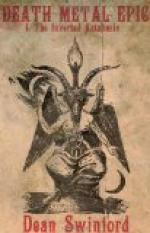On drawing near them, Chiron is amazed to perceive one of the intruders is alive, as is proved by the fact that he casts a shadow and that stones roll beneath his tread! Noticing his amazement, Virgil explains he has been sent here to guide his mortal companion through the Inferno, and beseeches Chiron to detail a centaur to carry Dante across the river of blood, since he cannot, spirit-like, tread air. Selecting Nessus for this duty, Chiron bids him convey the poet safely across the bloody stream, and, while performing this office, the centaur explains that the victims more or less deeply immersed in blood are tyrants who delighted in bloodshed, such as Alexander, Dionysius, and others. Borne by Nessus and escorted by Virgil, Dante reaches the other shore, and, taking leave of them, the centaur “alone repass’d the ford.”
Canto XIII. The travellers now enter a wild forest, which occupies the second division of the seventh circle, where Virgil declares each barren thorn-tree is inhabited by the soul of a suicide. In the gnarly branches perch the Harpies, whose uncouth lamentations echo through the air, and who greedily devour every leaf that sprouts. Appalled by the sighs and wailings around him, Dante questions Virgil, who directs him to break off a twig. No sooner has he done so than he sees blood trickle from the break and hears a voice reproach him for his cruelty. Thus Dante learns that the inmate of this tree was once private secretary to Frederick II, and that, having fallen into unmerited disgrace, he basely took refuge in suicide. This victim’s words have barely died away when the blast of a horn is heard, and two naked forms are seen fleeing madly before a huntsman and a pack of mastiffs. The latter, pouncing upon one victim, tears him to pieces, while Dante shudders at this sight. Meantime Virgil explains that the culprit was a young spendthrift, and that huntsman and hounds represent the creditors whose pursuit he tried to escape by killing himself.
Canto XIV. Leaving this ghastly forest, Dante is led to the third division of this circle, a region of burning sands, where hosts of naked souls lie on the ground, blistered and scathed by the rain of fire and vainly trying to lessen their pain by thrashing themselves with their hands. One figure, the mightiest among them, alone seems indifferent to the burning rain, and, when Dante inquires who this may be, Virgil returns it is Capaneus (one of the seven kings who besieged Thebes[17]), who, in his indomitable pride, taunted Jupiter and was slain by his thunder-bolt.
Treading warily to avoid the burning sands, Virgil and his disciple cross a ruddy brook which flows straight down from Mount Ida in Crete, where it rises at the foot of a statue whose face is turned toward Rome. Virgil explains that the waters of this stream are formed by the tears of the unhappy, which are plentiful enough to feed the four mighty rivers of Hades! While following the banks of this torrent, Dante questions why they have not yet encountered the other two rivers which fall into the pit; and discovers that, although they have been travelling in a circle, they have not by far completed one whole round of the gigantic funnel, but have stepped down from one ledge to the other after walking only a short distance around each circumference.




